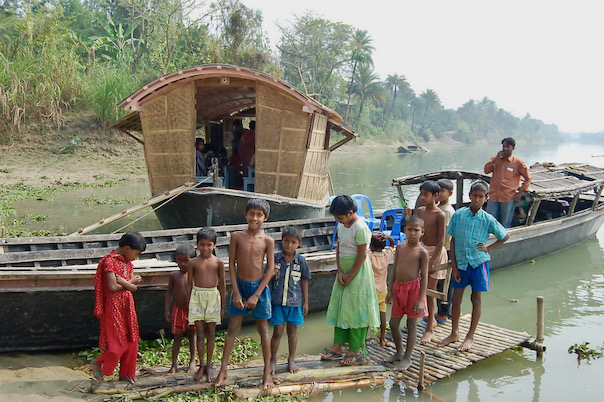BANGLADESH
The Floating Schoolhouse
By Chadd McGlone
Chapel Hill, NC, United States
Can you imagine going to school on a boat? What would you think if instead of driving to school, a floating classroom came to your house every day? This is how it happens in northwest Bangladesh for hundreds of students.
Shidhulai Swanirvar Sangstha is one of the nonprofit organizations that runs these floating schools in the Chalanbeel region. Flooding is a big problem in this wetland area, preventing children from getting to school. If the students can’t come to class, then class will come to the students!
Water Worries
In the rainy season, from July to October, the rivers can surge up to 12 feet. Roads are washed away, and houses are destroyed. Most of the population lives in lowland areas, so it is estimated that the floods affect five million people.
Every year, students are forced to drop out of school because of difficulties in transportation. Now, with climate change, rivers rise an average of 14 inches above previous expanses. Scientists have predicted an increase of six feet in this century. Bangladesh is considered one of the world’s most climate-vulnerable countries, so solutions are paramount.
A Boat Can Be a Schoolhouse
The boats that function as floating schools are approximately 50 feet long and 15 feet across. On average these can accommodate 30 students and their teacher. The boats are based on the strong structure of a traditional noka design, used for centuries in Bangladesh. Nontraditional elements have also been included, such as solar panels to power computers on the boats. This eco-friendly idea is one of the reasons why floating schools have been a great success.
On a typical day, a student sits outside her house on the river waiting for her school to arrive. Once onboard the boat, classes are held in a variety of important subjects. Students may learn to identify local species of birds and fish and even make their own floating gardens.
And So Much More
These boats are not just for kids! The founders of the organization have tried to reach the general population by outfitting boats to offer other services:
- seminars on women’s health, nutrition, hygiene, sustainable farming
- libraries
- health clinics
Rivers don’t have to be barriers. Riding waves of opportunity, they can be the future.
Have a suggestion for this story? We’d love for you to submit it!


Blank
Blank
Math Resources
Learning Activities:
- Multiplication (Grades 4–5)
- Connecting to the Standards: The Number System (Grade 6)
Sample Problems:
- What is the area of the boat, given the dimensions mentioned in the story?
- Imagine you are a teacher of a floating school. You need to teach five subjects each day. You also need to give your students a break to stretch their legs every 45 minutes. Design your school day’s schedule.
- Graph what the rise in water level looks like if it increases 14 inches per year. Repeat this in centimeters. In 100 years, how much will the river have risen? Does your answer make sense?
Social Justice Question
Given the effect of climate change, what responsibility do you believe countries with high carbon dioxide emissions should have in supporting these floating schoolhouses financially?
Explore Further
- Website of Shidhulai Swanirvar Sangstha
- New York Times article
- National Public Radio story
- Video of solar-powered boats
Share Your Story
Write your own Global Math Story and send it to us!
Sorry, the comment form is closed at this time.